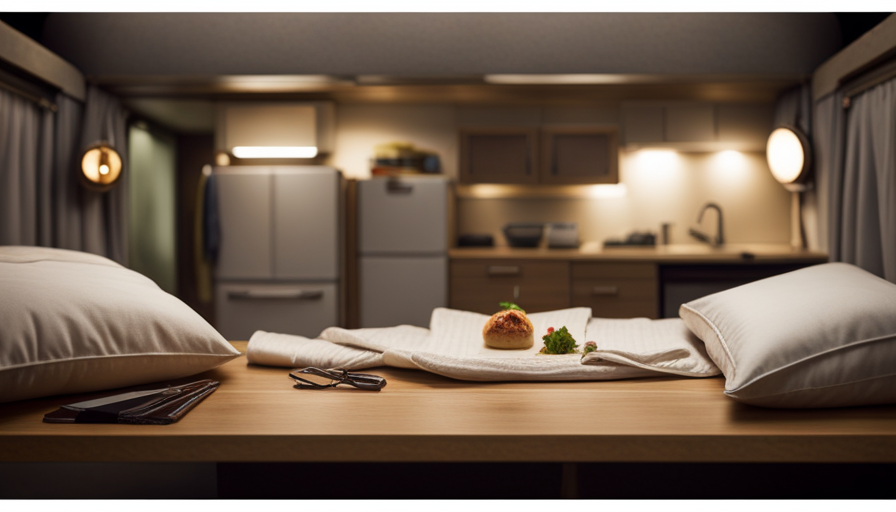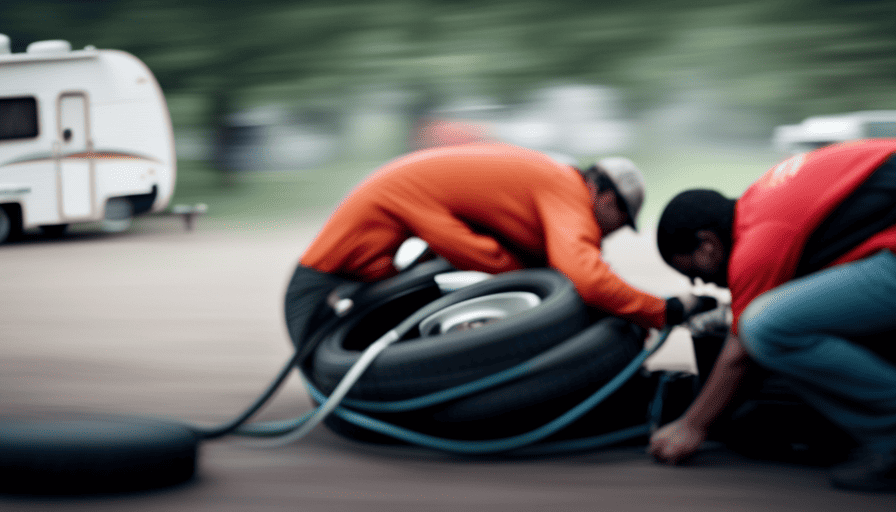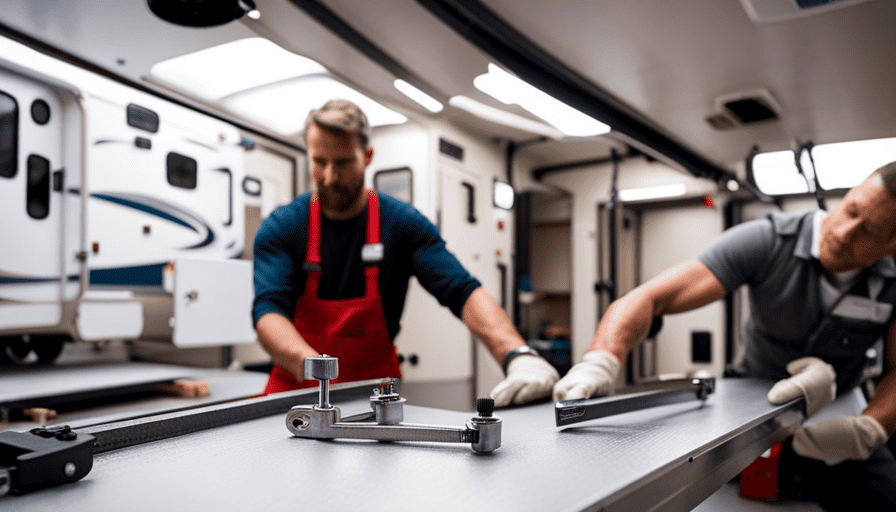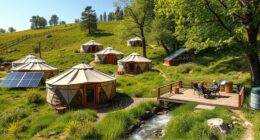Imagine this scenario: you’re enjoying a camping trip, immersed in the wonders of the natural world, when unexpectedly, the air gets colder. It’s at this moment you understand the value of a heated and comfortable camper. No need to worry! Our detailed guide on activating the heating in your camper has everything you need.
In this article, we will walk you through the necessary steps to ensure your camper’s heating system is up and running smoothly. From understanding the heating system to monitoring carbon monoxide levels, we leave no stone unturned.
Firstly, we’ll help you comprehend the inner workings of your camper’s heating system. Then, we’ll guide you through checking the thermostat settings and ensuring the propane tank is filled.
Next, we’ll show you how to turn on the propane valve and set the thermostat to your desired temperature. Additionally, we’ll teach you how to adjust the vents for proper airflow and suggest using additional heating methods for extra warmth.
Lastly, we’ll emphasize the importance of monitoring carbon monoxide levels and practicing safety precautions.
So, let’s dive in and learn how to keep your camper warm and toasty during those chilly outdoor adventures!
Key Takeaways
- Understanding the different types of heating systems in campers: propane furnaces, electric heaters, heat pumps
- Importance of inspecting and maintaining the camper’s heating system, including checking for propane leaks and cleaning the furnace
- Tips for troubleshooting common issues with camper heating systems, such as pilot light problems and thermostat malfunctions
- Practicing safety precautions, such as monitoring carbon monoxide levels, proper ventilation, and installing detectors, to ensure a warm and cozy camper while minimizing risks.
Understand Your Camper’s Heating System
To turn the heat on in your camper, you need to understand how your camper’s heating system works. RV heating options can vary depending on the type of camper you have.
The most common heating systems in campers are propane furnaces, electric heaters, and heat pumps. Propane furnaces are the most popular choice, as they provide efficient and reliable heat. However, they require a propane supply and regular maintenance to ensure safe operation.
Electric heaters are a good option if you have access to shore power or a generator, but they may not be as effective in colder temperatures.
Heat pumps are another option, which can provide both heating and cooling capabilities. They are more energy efficient but may not work well in extremely cold weather.
Common issues with camper heating systems include pilot light problems, thermostat malfunctions, and insufficient airflow. It is important to regularly inspect and clean the furnace and check for any leaks in the propane system.
Additionally, it is crucial to ensure that the thermostat settings are accurate and functioning properly. This will help maintain a comfortable temperature inside the camper. To check the thermostat settings, simply adjust the temperature to the desired level and listen for the furnace to kick on.
Check the Thermostat Settings
Make sure you’ve adjusted the thermostat settings to your desired temperature and comfort level, so that you can cozy up and enjoy the warmth inside your home on wheels.
When it comes to checking the thermostat settings in your camper, it’s important to understand how to troubleshoot any issues that may arise. One common mistake people make is not properly calibrating the thermostat. This can lead to inaccurate temperature readings and an uncomfortable living environment.
To troubleshoot this issue, start by turning off the power to the thermostat and removing the cover. Check for any loose wires or connections, and tighten them if necessary. Additionally, make sure the thermostat is clean and free of any dust or debris that may be affecting its functionality. If you’re still experiencing issues, it may be time to replace the thermostat altogether.
Once you’ve ensured that your thermostat is working properly, it’s important to move on to the next step: ensuring the propane tank is filled. This is crucial for your camper’s heating system, as propane is the fuel that powers it. Without a full propane tank, you won’t be able to generate the heat needed to keep you warm inside.
To check the propane levels, locate the tank and look for the gauge. If it’s reading low, it’s time to refill it.
By following these steps, you’ll be one step closer to enjoying a warm and cozy camper experience.
Ensure the Propane Tank is Filled
After checking the thermostat settings, it’s crucial to ensure that the propane tank in our camper is filled to keep us warm and cozy. Here are a few steps to troubleshoot the propane tank and explore camper heating alternatives:
-
Inspect the propane level: Begin by examining the tank gauge to determine if it’s filled. If the gauge indicates low propane levels, it’s time for a refill.
-
Check for leaks: Safely inspect the propane tank and connections for any signs of leaks. Apply a soapy water solution to the connections and look for bubbles. If bubbles appear, there may be a leak, and it’s crucial to address it before using the propane.
-
Refill the tank: If the propane level is low, it’s time to refill the tank. Locate a reputable propane supplier or visit a nearby gas station that provides propane filling services.
-
Consider alternative heating methods: While troubleshooting the propane tank, it’s wise to explore alternative heating methods for your camper. These can include electric heaters, portable propane heaters, or even a wood-burning stove if your camper is equipped for it.
Once the propane tank is filled or alternative heating methods are in place, we can move on to the next step of turning on the propane valve to begin heating our camper.
Turn on the Propane Valve
As you approach the propane valve, a sense of anticipation fills the air, knowing that with just a simple twist, warmth and comfort will soon envelop your camper.
Before turning on the propane valve, it’s crucial to prioritize propane safety. Make sure that the area around the valve is clear of any debris or flammable materials. Additionally, check for any signs of damage or leaks in the propane system. If you detect any issues, it’s essential to troubleshoot them before proceeding.
Once you’ve ensured propane safety, it’s time to turn on the propane valve. Locate the valve, usually near the propane tank, and turn it counterclockwise to open it. You may hear a slight hissing sound as the gas flows through the system. If you don’t hear any sound or suspect a problem, consult the manufacturer’s instructions or seek professional assistance to troubleshoot the ignition.
Now that the propane valve is open, you can transition into setting the thermostat to your desired temperature. By adjusting the thermostat, you can control the level of warmth that fills your camper. Remember to choose a comfortable temperature that suits your preferences and enjoy the cozy atmosphere that awaits you.
Set the Thermostat to Your Desired Temperature
Now that the propane valve’s been opened, it’s time to adjust the thermostat to create the perfect ambiance inside your cozy camper. Understanding thermostat settings is essential for maintaining a comfortable temperature.
Most campers have a simple thermostat with basic controls. To set the temperature, locate the temperature control knob on the thermostat. Turn the knob to your desired temperature, ensuring it’s set to the heating mode. It’s important to note that the thermostat may have a temperature range marked on it, so be mindful of that when making adjustments.
Once you’ve set the temperature, it’s crucial to maintain proper airflow throughout your camper. Make sure all vents and registers are open to allow warm air to circulate freely. Also, check that there are no obstructions blocking the vents, such as furniture or curtains. This will help ensure that the heat is distributed evenly and efficiently.
Now that you have properly adjusted the thermostat and ensured proper airflow, it’s time to wait for the heater to ignite. This process may take a few minutes, so be patient. You may hear a clicking sound as the heater ignites, and then warm air will start flowing through the vents.
In the next section, we’ll discuss how to monitor and maintain the heating system in your camper.
Wait for the Heater to Ignite
Are you wondering when the heater will finally ignite and start warming your cozy camper? Well, let me walk you through the process. Once you’ve set the thermostat to your desired temperature, it’s time to wait for the heater to ignite.
This step requires a little patience, but don’t worry, I’ll also provide you with some troubleshooting tips and maintenance suggestions.
Firstly, make sure that the propane supply is turned on and that there aren’t any leaks in the system. If you suspect a leak, it’s important to address it immediately for safety reasons.
Next, check if the pilot light is lit. If it’s not, you may need to relight it following the manufacturer’s instructions.
Additionally, check the furnace filter and clean or replace it if necessary. A dirty filter can obstruct airflow and prevent the heater from igniting.
If you’ve gone through these troubleshooting steps and the heater still won’t ignite, it may be time to seek professional help. A qualified technician can diagnose and repair any issues with your camper’s heating system.
Now that you’ve successfully ignited the heater, let’s move on to the next step: adjusting the vents for proper airflow.
Adjust the Vents for Proper Airflow
To ensure optimal warmth in your camper, it’s crucial to properly adjust the vents for efficient airflow. Vent placement plays a vital role in distributing heat evenly throughout the space, so it’s important to strategically position them.
Start by locating the vents in your camper and adjusting them so that warm air is directed towards the areas you want to heat the most. For example, if you spend most of your time in the living area, make sure the vents in that area are open and facing towards you. Similarly, if you have separate sleeping quarters, adjust the vents in that area accordingly.
In addition to vent placement, airflow control is another key factor in maximizing heat circulation. Most vents have a built-in control mechanism that allows you to adjust the airflow. This can be a simple lever or knob that you can slide or turn to regulate the amount of warm air coming out. Experiment with different airflow settings to find the one that provides the most comfortable temperature for you.
Now that you have adjusted the vents for proper airflow, consider using additional heating methods to supplement the warmth provided by your camper’s heater. This will ensure that you stay cozy in extremely cold conditions.
Consider Using Additional Heating Methods
Imagine a world where you can embrace the chill of winter by incorporating cozy blankets and portable electric heaters in your camper. When the built-in heating system in your camper isn’t sufficient, there are alternative heating options available that can keep you warm and cozy during your camping adventures. Here are four energy efficient heaters that you can consider using:
-
Ceramic Space Heaters: These compact heaters are known for their quick heating capabilities and energy efficiency. They provide a consistent and comfortable heat output, making them ideal for small spaces like campers.
-
Propane Heaters: Propane heaters are a popular choice among campers due to their portability and ability to provide instant heat. They’re easy to use and can be fueled by small propane canisters, making them convenient for camping trips.
-
Electric Fireplace Heaters: Electric fireplace heaters not only provide warmth but also create a cozy ambiance in your camper. They’re energy efficient and offer a realistic flame effect, giving you the feeling of a traditional fireplace.
-
Portable Radiant Heaters: These heaters emit infrared heat waves, which directly warm people and objects in their path. They’re efficient and can quickly heat up a small space, making them a great option for campers.
Consider using one of these alternative heating methods to stay warm and comfortable in your camper during cold weather. However, it’s important to monitor carbon monoxide levels to ensure your safety.
Monitor Carbon Monoxide Levels
Now that we’ve discussed using additional heating methods, let’s turn our attention to an important aspect of staying warm in a camper: monitoring carbon monoxide levels. Carbon monoxide is a colorless, odorless gas that can be extremely dangerous if not detected. That’s why it’s crucial to have carbon monoxide detectors installed in your camper. These detectors will alert you if there’s a buildup of carbon monoxide, allowing you to take necessary precautions to ensure your safety.
In addition to having detectors, it’s also important to be aware of the ventilation requirements in your camper. Proper ventilation helps prevent the accumulation of carbon monoxide by allowing fresh air to circulate and toxic gases to escape. Make sure to open windows and vents when using heating appliances and be mindful of any obstructions that may hinder airflow.
Remember, carbon monoxide can be deadly, so it’s essential to take the necessary steps to protect yourself and your fellow campers. Now that we understand the importance of monitoring carbon monoxide levels and ensuring proper ventilation, let’s move on to the next section where we’ll discuss how to practice safety precautions to further safeguard against any potential hazards.
Practice Safety Precautions
Ensure your safety and enhance your camping experience by implementing these safety precautions. It’s crucial to prioritize your well-being while using a camper heater. Here are four important safety measures to follow:
-
Proper Ventilation: Adequate airflow is crucial when using a camper heater. Ensure that vents are open and unobstructed to prevent the buildup of harmful gases, such as carbon monoxide. Proper ventilation will help maintain a safe and comfortable environment inside your camper.
-
Regular Maintenance: Regularly inspect and clean your camper heater to prevent potential fire hazards. Remove any accumulated dust or debris and check for any loose or damaged parts. Additionally, ensure that all connections are secure and in good condition.
-
Fire Safety: Always keep a fire extinguisher within easy reach of your camper heater. Familiarize yourself with its operation and make sure it’s in good working condition. Additionally, avoid placing flammable materials near the heater and never leave it unattended.
-
Carbon Monoxide Detectors: Install carbon monoxide detectors inside your camper to monitor and alert you of any dangerous levels of this odorless gas. Test them regularly to ensure they’re functioning correctly.
By following these safety precautions, you can enjoy the warmth and comfort of your camper heater while minimizing the risks associated with improper ventilation and potential fire hazards. Stay safe and have a pleasant camping experience!
Frequently Asked Questions
How do I check the thermostat settings in my camper’s heating system?
To check the thermostat settings in your camper’s heating system, first, make sure the thermostat battery is fully charged. If the battery is fine, proceed to troubleshoot the thermostat wiring. Look for any loose connections or frayed wires that may be causing issues. It’s important to address any wiring problems promptly to ensure the proper functioning of your heating system.
Regularly checking these components will help maintain a cozy and comfortable environment in your camper.
What should I do if the propane tank is not filled?
If the propane tank isn’t filled, there are a few things you can do as alternative heating options. First, check if there’s an electrical outlet nearby that you can use to power a portable electric heater. If that’s not an option, you can also consider using a camping stove or a portable propane heater. Additionally, it’s important to troubleshoot the propane tank connection to make sure there aren’t any leaks or issues preventing it from being filled.
How do I turn on the propane valve in my camper?
To turn on the propane valve in our camper, we need to prioritize safety. Start by checking for any propane leaks or unusual smells. If everything seems fine, locate the propane tank and ensure it’s securely connected.
Next, turn the valve handle counterclockwise to open it. If you encounter any issues, such as a lack of heat, check the propane tank level and make sure it’s filled.
Troubleshooting heat issues may involve checking the thermostat settings or inspecting the furnace for any blockages.
What should I do if the heater doesn’t ignite after waiting for some time?
If the heater doesn’t ignite after waiting for some time, there are a few troubleshooting steps you can take. First, check if the propane tank is full and the valve is open. Ensure that the thermostat is set to a temperature higher than the current room temperature.
If the issue persists, try resetting the heater by turning it off and on again. If all else fails, consider alternative heating options such as electric heaters or portable propane heaters.
Are there any additional heating methods I can use in my camper?
Sure, there are alternative heating options you can use in your camper. One option is to use a portable electric heater, which can provide additional warmth.
Another option is to insulate your camper for better heat retention. This can be done by adding insulation to the walls, floor, and ceiling, as well as using thermal curtains and window coverings. By insulating your camper, you can help retain heat and make it more comfortable during colder weather.
Conclusion
So there you have it, folks! We’ve covered all the steps to turn on the heat in your camper. Now, you can cozy up and enjoy those chilly nights on the road.
Just remember, safety first! Keep an eye on those carbon monoxide levels and make sure to follow all the necessary precautions. With a little know-how and the right equipment, you’ll be able to keep warm and comfortable in your home away from home.
Happy camping, and may the warm winds of adventure guide you on your journey!










